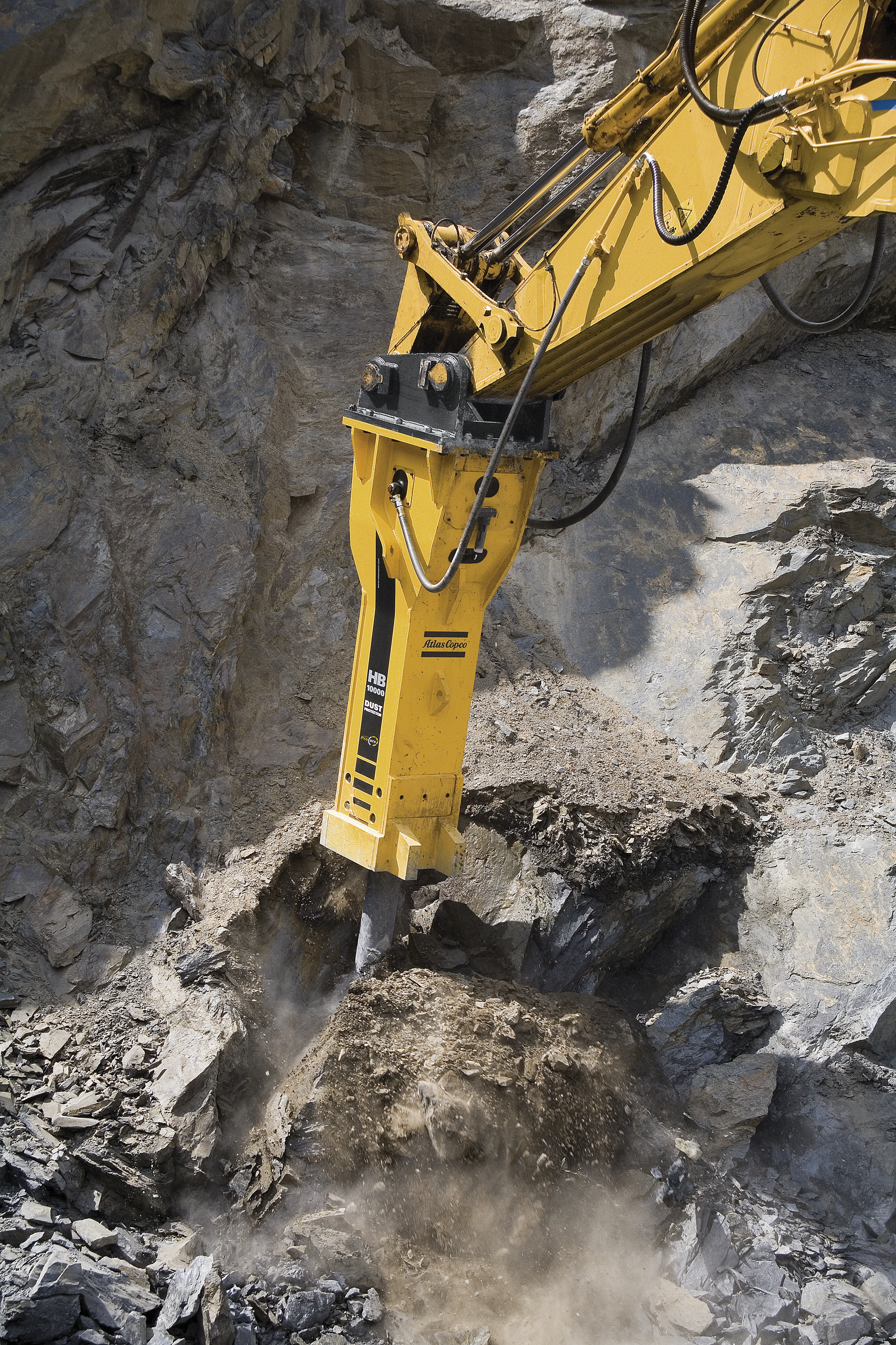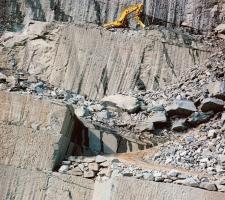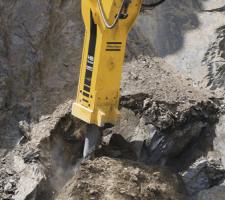
Developments in hydraulic breaker technology means the latest units offer better reliability and more power than ever before. ABE looks at how these changes are influencing the European quarrying sector
Increasing numbers of quarries have moved from drill and blast to using hydraulic breakers for primary extraction over the last decade. But is this being driven by environmental considerations or is uptake growing mainly because breaker technology is improving? According to industry experts, it is a combination of both factors which is making breakers a more viable option for quarry operators.
"Quarries located near communities that use drill and blast operations are increasingly coming up against political and environmental problems because of the level of noise, dust and vibration that is often generated," said
"Power delivered by breakers has tripled over the last 30 years enabling them to be used in a wider range of quarries than before," said Treger. "In addition the reliability has also been improved."
Technology changes
Computer aided three dimensional design has enabled breaker manufacturers to improve their designs long before the breaker goes to the prototyping stage. "Computer design has also helped to improve production quality by taking designs digitally straight to the CNC machines and enabled us to offer lifetime guarantees," said Siltanen.
The way breakers are now used in quarries is also influencing design. "During the research and development phase for our BR3088 breaker, we talked to our quarry customers to find out what they wanted from new designs," said Siltanen. "The need for extended service intervals and less down time was almost unanimous, as well as making day to day use and maintenance easier." To increase the service interval and improve reliability, while not increasing the cost per unit is a challenge, according to Siltanen, and the company has focused on reducing the number of components to achieve this. "Fewer parts means that there is less to go wrong and servicing is simpler," he said.
Other areas that have been significantly improved include seals and bushes - both key developments in terms of greater performance and reliability.
Advances in seal technology allow units to operate at higher flow rates and pressure than ever before. "Research and development for seals is continuous," said Treger. "We cannot rely on suppliers to meet our demand for development - the needs for a hydraulic breaker are very different to a standard hydraulic rim because of the higher percussive speeds." Treger refused be drawn on how Atlas Copco's seal design has changed in recent years but added that seals are what differentiate between good and poor breaker designs.
On the subject of bush design, Treger said that introduction of brass bushes, instead of steel on steel designs, in the last few years has helped to improve breaker performance by reducing friction. "Developments in wear bushes go together with tool innovation," he said. "The design of the wear bushes and tool is critical to reducing premature breakage." (see box).
Another important development is the hydraulic system that protects against damage caused by blank firing, when a hammer's tool strikes into the air rather than against rock. In early breaker designs blank firing could cause massive internal damage as the energy generated by the hammer would be circulated inside the hydraulics rather than delivered to the rock.
"Modern breakers feature energy recovery system to transfer energy not absorbed by the rock into the next stroke to increase percussive performance," said Treger.
Excavator design has also improved and the latest machines are better able to cope with the mechanical forces so that booms and dippers are much less likely to crack, while hydraulics are now better able to cope with the heat generated by a breaker. Contractors no longer routinely use the oldest excavator in the fleet for breaker work rather than risking a new machine.
Addition of silencing and vibration controls on hydraulic breaker has also helped in improving their environmental performance. "Silencing systems were originally developed for urban construction and demolition applications in line with new EU legislation introduced in 2000 to guarantee the maximum sound power level," said Treger. "Silencing in quarries is not as critical, although it may be useful on some sites close to residential properties, but vibration damping has been a significant development for primary breaking applications."
Minimising maintenance
With breakers moving into primary breaking, reducing breaker down time is becoming increasingly important as they become more critical to the overall operation. This has led to the addition of auto-lube systems on many larger breakers to ensure they are correctly maintained even when switched from carrier to carrier.
Tracking service hours on breakers can be difficult if they are used on several different carriers but Sandvik is working on a new feature, which should help improve maintenance planning.
"We already have a Ramdata meter on some of our models to record operation data but we are working on developing the next generation, which will have more features," said Siltanen. "We expect to launch the updated system in 2008 and it will record a number of different operation parameters, such as number of service hours. Detailed information about how and when the breaker is being used will allow operators to plan preventative maintenance more effectively." Siltanen also expects the technology developed for utility sized hydraulic breakers to filter through to quarry sized units in the long term. "Smaller units aimed at the utility and rental markets feature composite bushings which do not require greasing," he explained. "These are now well accepted in the rental markets and in time this technology could transfer to the quarrying market to help reduce maintenance." While future developments in hydraulic breakers are likely to include increased diagnostics and recording of service data, Siltanen also expects further environmental improvements. "Dust is a big issue for quarry operators," he said. "Design changes have helped reduce the impact of dust on breaker operation but we now need to reduce release of dust into the atmosphere. We are currently researching use of water sprays, similar to those used in tunnelling applications, and vacuum systems."
Environmental footprint
The concern of quarry operators about their environmental impact is extending out of the quarry and to the manufacturing processes used for their equipment too. "We are now using water based paints and natural gas for heat treatment," said Siltanen. "This is partly driven by changes in legislation but customers in Europe are now demanding to know what the environmental footprint of the equipment they're buying is." According to Siltanen, Sandvik spent some time researching the implications of water based paint before switching production to the less-harmful technique. "Quality control is essential and the breakers need to be double painted but the customer will not notice any difference in the finished product," he explained. "The only difference is the lower emissions levels."
Market forces
According to the Committee for European Construction Equipment, the global market for hydraulic breakers was around 30,000 units in 2006. However, both Treger and Siltanen believe that the true figure may be double that at 56,000 to 60,000 for all weight classes, with around 30% sold into the quarrying market.Tool selection
Performance of a hydraulic breaker in a quarry depends on more than just the size of the unit and the oil flow provided by the carrier. The tool size and shape can also impact on productivity.
"The choice of tool will depend on a number of factors, including the rock type, required production volume and also customer preference," said Treger. "Operators carrying out direct mining in homogeneous rock tend to opt for a blunt tool for a high energy transfer. But for working in fractured material, a narrow chisel or pyramid tool is generally preferred."
Tool life is dependant on the silica content of the rock and, according to Treger, this can vary from 200 hours to 1500 hours but in some extreme conditions it can be as little as just a couple of hours.
Unlike drilling tools, those used on breakers cannot be reground for further use and have to be recycled. "Using more wear resistant steel will help extend tool service life," said Treger. "But development of replaceable tips would be fantastic for the industry - less wastage and faster replacement."
"Sales for all sizes of hydraulic breakers are growing and, if the predictions of the carrier manufacturers are to be believed, demand is likely to continue increasing for the next two to three years," said Treger. "We are also expecting sales into the aggregates industry to increase over the same period as more quarries look to breakers to meet production demand and environmental constraints." While increased demand from the quarrying sector is likely to mean larger volumes, it will also mean larger units. Many quarry operators in Europe are starting to use larger equipment, according to Treger. "There is a clear trend that customers are buying bigger equipment. A few years ago most quarry operators were buying 25 to 30tonne carriers and now the 35 to 40tonne weight class is more popular. The demand is now filtering through to attachments." Atlas Copco has responded to this demand with the launch of the 10tonne HB10000 at Bauma, while it is not the first breaker of this size, it is currently the largest in production.
"There is a strong market for 6 to 7tonne breakers in the quarrying market but demand for larger attachments for use with the increasing range of heavier carriers is also growing," said Treger.
According to Treger, the latest breakers are much more powerful than previous models and can now be used on rock with strengths of up to 250MPa. "Although it is possible to break stronger rock with hydraulic breakers, the production rate is still critical when deciding to make the switch from drilling and blasting to breakers for primary breaking," he explained. "The solution for each quarry is different and will depend on the geology.
"The cost per tonne of production is also important so we have to work with operators to ensure they are using the right breaker to meet their production needs and budget."

















